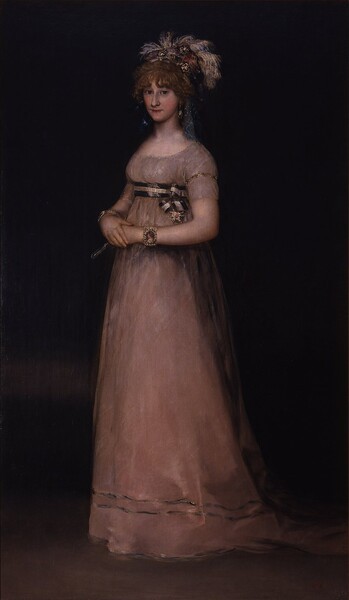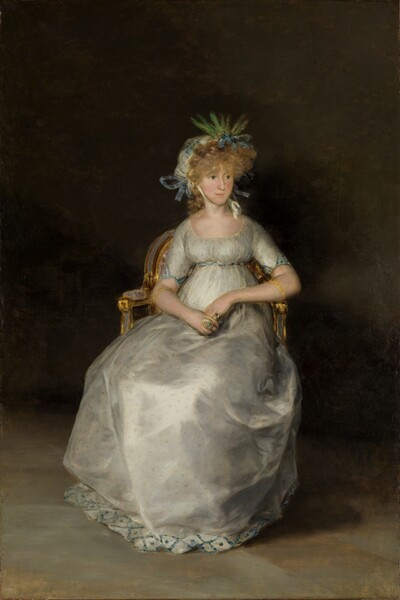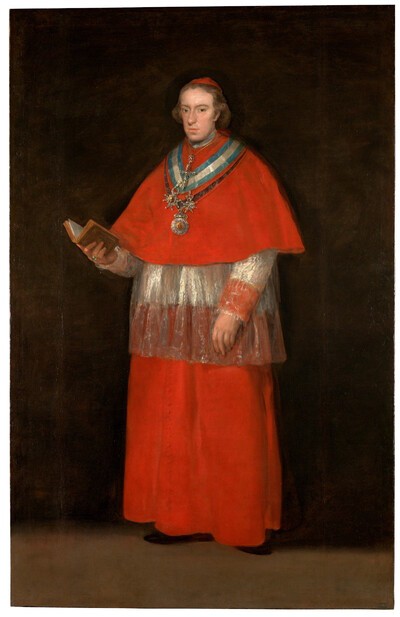- Cronología
- Ca. 1800 - 1801
- Ubicación
- The Uffizi Gallery, Florence, Italy
- Dimensiones
- 198 x 115,5 cm
- Técnica y soporte
- Oil on canvas
- Reconocimiento de la autoría de Goya
- Documented work
- Titular
- Istituti Museali della Soprintendenza Speciale per il Polo Museale Fiorentino
- Ficha: realización/revisión
- 20 Jan 2010 / 16 Jun 2023
- Inventario
- 9484
Carlota Luisa Godoy y Borbón (+ 1886), Duchess of Sueca and Countess of Chinchón, only granddaughter of the Infante Don Luis de Borbón and Mª Teresa de Vallabriga, kept a good part of the family heritage in her palace in Boadilla del Monte (Madrid), including the portrait of her aunt Mª Luisa. In 1904 it left there, along with other paintings, bound for Florence, remaining in the hands of the descendants of Luis Rúspoli Godoy (+ 1893), second son of Carlota Luisa. In 1972 it entered the Galleria degli Uffizi in Florence..
María Luisa was the youngest daughter of the infante Don Luis de Borbón and Mª Teresa Vallabriga. Sister, therefore, of Mª Teresa, future Countess of Chinchón and wife of Manuel Godoy, and Luis María, invested Cardinal Primate and Archbishop of Toledo. Goya, well received by the Infante Don Luis, had the opportunity to portray all the members of this family. Mª Luisa married the Duke of San Fernando de Quiroga, leaving no descendants. For a long time it was erroneously assumed that this portrait represented her sister Mª Teresa.
Maria Luisa is depicted here standing full-length, against a dark, neutral background, with her body turned to her right and her hands clasped, holding a fan. She wears a vaporous long white gown with pinkish transparencies, low-cut and short-sleeved. Her curly hair is tied back with a feathered headdress from which a blue ribbon hangs at the nape of her neck. As the only sign of ostentation, she discreetly wears the sash and starry cross of the order of Maria Luisa, which was granted to her in 1800, and some jewelry (bracelet, necklace and earrings).
The sitter, with a seductive gaze, smiles shyly, imbued with the official nature of the portrait. The tenderness and subtlety of the portrait stand out, both in the psychological capture of the sitter and in the treatment of the textures of the dress.
The restoration work done for the Goya e Italia exhibition, in Zaragoza, provided an opportunity to eliminate some previous retouching work that was affecting the background on the right-hand side. An x-ray of the painting revealed, in the lower part of the figure, a sketch of one or two heads which, according to Joan Sureda, are similar in appearance to the caricatured faces of Goya’s Caprices.
-
Goya. La década de Los CaprichosMadrid1992organized by Real Academia de Bellas Artes de San Fernando sponsored by Fundación Central Hispano, Madrid, consultant editor Nigel Glendinnig. From October 26th 1992 to January 10th 1993cat. 10
-
Il Gran Teatro del Mondo. L’Anime e il Volto del SettecentoPalazzo RealeMilan2003From November 13th 2003 to March 28th 2004
-
Goya e ItaliaMuseo de ZaragozaZaragoza2008organized by the Fundación Goya en Aragóna, consultant editor Joan Sureda Pons. From June 1st to September 15th 2008cat. 273
-
Goya y el infante don Luis: el exilio y el reino.Palacio Real, MadridMadrid2012Arte y ciencia en la época de la ilustración española. Responsable científico Francisco Calvo Serraller. Del octubre de 2012 a enero de 2013.cat. 22
-
Goya: Order and disorderMuseum of Fine ArtsBoston2014cat. 118
-
BarcelonaPolígrafa1970vol. I, p. 118, cat. 433
-
L’opera pittorica completa di GoyaMilanRizzoli1974p.113 (il.) y p.114, cat. 369
-
Goya e Italia, 2 vols.ZaragozaFundación Goya en Aragón y Turner2008vol. I, p. 195 (il.), vol II, cat. 273,
-
Goya y el infante don Luis de Borbón (Homenaje a la “Infanta” María Teresa de Vallabriga)ZaragozaIbercaja1996




